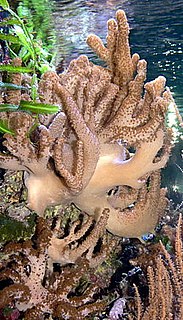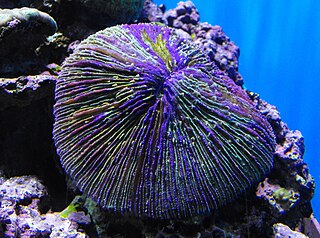
Zoanthids are an order of cnidarians commonly found in coral reefs, the deep sea and many other marine environments around the world. These animals come in a variety of different colonizing formations and in numerous colors. They can be found as individual polyps, attached by a fleshy stolon or a mat that can be created from small pieces of sediment, sand and rock. The term "zoanthid" refers to all animals within this order Zoantharia, and should not be confused with "Zoanthus", which is one genus within Zoantharia.

Alcyonacea, or soft corals, are an order of corals. In addition to the fleshy soft corals, the order Alcyonacea now contains all species previously known as "gorgonian corals", that produce a more or less hard skeleton, though quite different from "true" corals (Scleractinia). These can be found in suborders Holaxonia, Scleraxonia, and Stolonifera. They are sessile colonial cnidarians that are found throughout the oceans of the world, especially in the deep sea, polar waters, tropics and subtropics. Common names for subsets of this order are sea fans and sea whips; others are similar to the sea pens of related order Pennatulacea. Individual tiny polyps form colonies that are normally erect, flattened, branching, and reminiscent of a fan. Others may be whiplike, bushy, or even encrusting. A colony can be several feet high and across, but only a few inches thick. They may be brightly coloured, often purple, red, or yellow. Photosynthetic gorgonians can be successfully kept in captive aquaria.

Fire corals (Millepora) are a genus of colonial marine organisms that exhibit physical characteristics similar to that of coral. The name coral is somewhat misleading, as fire corals are not true corals but are instead more closely related to Hydra and other hydrozoans, making them hydrocorals. They make up the only genus in the monotypic family Milleporidae.

The pulsating xenid is a species of soft coral in the family Xeniidae.

Blue coral is a species of colonial coral. It is the only octocoral known to produce a massive skeleton. This skeleton is formed of aragonite, similar to that of scleractinia. Individual polyps live in tubes within the skeleton and are connected by a thin layer of tissue over the outside of the skeleton.

Goniopora, often called flowerpot coral, is a genus of colonial stony coral found in lagoons and turbid water conditions. Goniopora have numerous daisy-like polyps that extend outward from the base, each tipped with 24 stinging tentacles which surrounds a mouth.

The open brain coral is a brightly colored free-living coral species in the family Merulinidae. It is the only species in the monotypic genus Trachyphyllia and can be found throughout the Indo-Pacific.

Holaxonia is a suborder of soft corals, a member of the phylum Cnidaria. Members of this suborder are sometimes known as gorgonians and include the sea blades, the sea fans, the sea rods and the sea whips. These soft corals are colonial, sessile organisms and are generally tree-like in structure. They do not have a hard skeleton composed of calcium carbonate but have a firm but pliable, central axial skeleton composed of a fibrous protein called gorgonin embedded in a tissue matrix, the coenenchyme. In some genera this is permeated with a calcareous substance in the form of fused spicules. Members of this suborder are characterized by having an unspiculated axis and often a soft, chambered central core. The polyps have eight-fold symmetry and in many species, especially in the families Gorgoniidae and Plexauridae, contain symbiotic photosynthetic algae called zooxanthellae. These soft corals are popular in salt water aquaria.

Fungia is a genus of corals in the family Fungiidae. It is monotypic with the single species Fungia fungites, which is found growing on reefs in the Indo-Pacific.

Galaxea is a genus of colonial stony corals in the family Euphylliidae. Common names include crystal, galaxy, starburst and tooth coral. They are abundant on reefs in the Indo-Pacific region and the Red Sea. They are found in water less than 20 metres (66 ft) deep and favour turbid sites. They are sometimes kept in reef aquaria.

Nephtheidae is a family of soft corals in the phylum Cnidaria. Members of this family are known as carnation corals, tree corals or colt soft corals. They are very attractive and show a wide range of rich and pastel colours including reds, pinks, yellows and purples. They are popular with reef aquarium hobbyists.

Plexaura is a genus of gorgonian-type octocorals in the family Plexauridae.

Plexauridae is a family of marine colonial octocorals in the phylum Cnidaria. Members of this family are found in shallow tropical and subtropical seas. Many species contain symbiotic photosynthetic protists called zooxanthellae.

Plexaurella nutans, the giant slit-pore sea rod, is a tall species of soft coral in the family Plexauridae. It is a relatively uncommon species and is found in shallow seas in the Caribbean region.

Paramuricea clavata, the violescent sea-whip, is a species of colonial soft coral in the family Plexauridae. It is found in shallow seas of the north-eastern Atlantic Ocean and the north-western Mediterranean Sea as well as Ionian Sea. This species was first described by the French naturalist Antoine Risso in 1826.

Alcyonium coralloides, commonly known as false coral, is a colonial species of soft coral in the family Alcyoniidae. It is native to the northeastern Atlantic Ocean and the Mediterranean Sea. In the former location it generally grows as sheets or small lobes but in the latter it is parasitic and overgrows sea fans.

Antillogorgia bipinnata, the bipinnate sea plume, is a species of colonial soft coral, a sea fan in the family Gorgoniidae. It is found in the Caribbean Sea. It was first described as Pseudopterogorgia bipinnata in 1864 by the American zoologist Addison Emery Verrill. Williams and Chen (2012), transferred all the Atlantic species of Pseudopterogorgia to Antillogorgia.

Pseudoplexaura is a genus of gorgonian-type octocorals in the family Plexauridae. They form tall, branching, tree-like colonies and are native to reefs in the Caribbean Sea and the Gulf of Mexico.
Pseudoplexaura porosa, commonly known as the porous sea rod or the porous false plexaura, is a species of gorgonian-type colonial octocoral in the family Plexauridae. It is native to the Caribbean Sea and the Gulf of Mexico.
Muriceopsis is a genus of gorgonian-type, branching colonial octocorals in the family Plexauridae. They are found on shallow water reefs and are capable of developing sweeper tentacles. The growth of these corals is rapid and they can be kept in a reef aquarium.


















